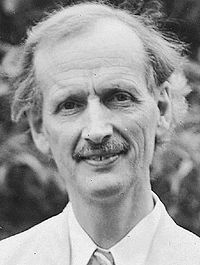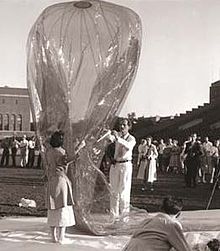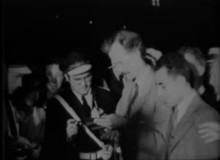- Jean Piccard
-
This article is about the chemist, professor and balloonist. For the 17th century French astronomer, see Jean Picard.
Jean Piccard 
Jean Piccard visiting Brigham Young University in 1938Born January 28, 1884
Basel, SwitzerlandDied January 28, 1963 (aged 79)
Minneapolis, USANationality Swiss from 1931 American Fields Inorganic chemistry Institutions University of Munich,
University of Lausanne,
University of Chicago,
University of MinnesotaAlma mater ETH Zürich phd 1909 Jean Felix Piccard (Basel, Switzerland, January 28, 1884 – January 28, 1963, Minneapolis, Minnesota), also known as Jean Piccard, was a Swiss-born American chemist, engineer, professor and high-altitude balloonist. He invented clustered high-altitude balloons, and with his wife Jeannette, the plastic balloon. Piccard's inventions and co-inventions are used in balloon flight, aircraft and spacecraft. Captain Jean-Luc Picard of Star Trek is named for one or both of him and his twin brother Auguste - in fact, it was sometimes hinted that the character may be descended from the scientist.
Contents
Family
Piccard and Jeannette Ridlon met at the University of Chicago where he taught and she received her masters degree. They married and had three sons, John, Paul and Donald, and also had foster children. During the 1980s, Gene Roddenberry named the character Captain Jean-Luc Picard in Star Trek: The Next Generation for one or both of the Piccard brothers and derived Jean-Luc from Jean's name.[1][2][dead link]
Stratosphere flight
Piccard was the co-pilot for his wife Jeannette on the third and final voyage of the Century of Progress. The largest balloon in the world was conceived for him to fly at the World's Fair in 1933 but was flown there by US Navy pilots who were licensed.[3] After this flight he created the liquid oxygen converter when the liquid failed to vaporize on descent after the cabin doors were open.[4] Piccard developed a frost-free window, that was used on this flight and later by the Navy and Air Force in the B-24 Liberator or B-26 Marauder. He used blasting caps and TNT for releasing the balloon at launch and for remote release of external ballast from inside the sealed cabin. This was the first use of pyrotechnics for remote-controlled actuating devices in aircraft, an unpopular, revolutionary idea at the time. Later his student Robert R. Gilruth, who became the director of the NASA Manned Spacecraft Center, approved and used them in spacecraft.[5][6]
The July 21st, 1952 issue of The Canberra Times newspaper printed a front page article in which Mr. Picard claimed it would be possible for humans to fly to Mars with balloons as early as 1954, if anyone was willing to invest $250,000.
Plastic balloons
 Jeannette and Jean Piccard, University of Minnesota, 1936
Jeannette and Jean Piccard, University of Minnesota, 1936
In 1935 and 1936, to reduce weight and thus enabling a balloon to reach higher altitudes, plastic balloon construction began independently by Max Cosyns in Belgium, Erich Regener in Germany, and Thomas H. Johnson and Jean Piccard, then at the Franklin Institute Bartol Research Foundation in Swarthmore, Pennsylvania. Johnson suggested cellophane to Jean Piccard.[7]
Piccard with his wife co-invented the plastic balloon[8] and he designed and in 1936 flew a cellophane balloon built by his students. The balloon was unmanned, 25 feet wide, and made of tapered 33-foot gores and one-inch 3M Scotch transparent tape. Jean Barnhill, Harold Larson and Lloyd Schumacher cut the gores that fit together like an "orange peel." Harold Hatlestad built the radio equipment and Robert Silliman built the telemeter[9] that sent temperature and pressure data back. Robert Hatch and Silliman maintained radio contact from a station on the roof of the university armory until the radio's battery froze from insufficient insulation.[7][10] The balloon floated at 50,000 feet, and in ten hours traveled over 600 miles to near Huntsville, Arkansas.[7]
Cluster balloons
Developed with John Ackerman of the University of Minnesota and piloted by Jean Piccard in 1937 in Rochester, Minnesota, the first multi-celled balloon was called The Pleiades and was made of 98 latex rubber balloons. In a letter to Robert Gray of the Dewey and Almy Chemical Co. later published in Time magazine, Piccard describes how he broke balloons with a hunting knife and revolver to control his descent. A TNT charge released the cluster as he expected but sent burning excelsior down that destroyed the first Pleiades. He suggested to Gray that rock wool in place of excelsior would prevent similar accidents in the future.[11]
Balloon research stopped for the most part during World War II.[12]
In February 1946 with Otto C. Winzen, Jean Piccard proposed manned flight to the US Navy using clustered balloons made of thin plastic. In June the Office of Naval Research approved Project Helios and that year General Mills and the University of Minnesota contracted to build a cluster of 100 polyethylene balloons for atmospheric research.[13] Helios was designed to reach 100,000 feet for ten hours with a payload of instruments.[14]
Jean Piccard helped Winzen design the Skyhook polyethylene balloons that replaced Project Helios in 1947. Skyhook balloons were used unmanned for atmospheric research by the Navy and for manned flights by the US Air Force.[13][15] Later Jean Piccard developed electronics for emptying ballast bags.[4]
Piccard died on January 28, 1963 (his 79th birthday) in Minneapolis.
Piccard family
- Jules Piccard (professor of chemistry)
- Auguste Piccard (physicist, aeronaut, balloonist, hydronaut)
- Jacques Piccard (hydronaut)
- Bertrand Piccard (aeronaut, balloonist)
- Jacques Piccard (hydronaut)
- Jean Felix Piccard (organic chemist, aeronaut, and balloonist)
- Jeannette Piccard (wife of Jean Felix) (aeronaut and balloonist)
- Don Piccard (balloonist)
- Jeannette Piccard (wife of Jean Felix) (aeronaut and balloonist)
- Auguste Piccard (physicist, aeronaut, balloonist, hydronaut)
Notes
- ^ University of California et al. [and informal sources on Jean Piccard talk page] (2003). "Living With A Star: 3: Balloon/Rocket Mission: Scientific Ballooning". http://ds9.ssl.berkeley.edu/LWS_GEMS/3/scien.htm. Retrieved 2007-01-27.
- ^ Piccard, Elizabeth via National Public Radio (January 23, 2004). "Talk of the Nation: Science on Stage". http://www.npr.org/templates/story/story.php?storyId=1614132. Retrieved 2007-01-29.
- ^ a b US Centennial of Flight Commission (2003). "Jean Piccard". http://www.centennialofflight.gov/essay/Dictionary/Jean_Piccard/DI65.htm. Retrieved 2007-01-27.
- ^ Piccard, Don (2005). [via Web site marked private. "Balloon Information Resources: The Beginning"]. via Web site marked private.. Retrieved 2007-01-28.
- ^ Kraft, Christopher Jr. (2004). "Robert R. Gilruth in Biographical Memoirs V.84 92-111". National Academy of Sciences. http://books.nap.edu/openbook.php?record_id=10992&page=92. Retrieved 2007-01-30.
- ^ a b c Winker, J. A., via sample page (1986). "Scientific ballooning, past and present". American Institute of Aeronautics and Astronautics. http://www.aiaa.org/content.cfm?pageid=406&gTable=mtgpaper&gID=92979. Retrieved 2007-01-28.
- ^ Robert Rechs (November 21, 1983). "Who's Who of Ballooning - P". http://www.ballooninghistory.com/whoswho/who'swho-p.html. Retrieved 2007-01-27.
- ^ Gilruth, Dr. Robert (May 14, 1986). "NASM Oral History Project, Gilruth #2". Smithsonian National Air and Space Museum. http://www.nasm.si.edu/research/dsh/TRANSCPT/GILRUTH2.HTM. Retrieved 2007-01-27.
- ^ Aerospace Engineering and Mechanics (AEM) Department (July 23, 2004). "Some Notable Early Faculty Members". University of Minnesota. http://www.aem.umn.edu/info/history/03_NotableFaculty.shtml. Retrieved 2007-01-27.
- ^ Piccard, Jean via Robert Gray (August 16, 1937). "Egg Shell Landing". Time. http://www.time.com/time/magazine/article/0,9171,770771,00.html?promoid=googlep. Retrieved 2007-01-27.
- ^ Goebel, Greg (July 1, 2006). "A Short History Of Balloons & Ballooning: 3.0 The Stratosphere Expeditions". http://www.vectorsite.net/avbloon_3.html. Retrieved 2007-02-01.
- ^ Stekel, Peter (August 1997). "Don Piccard - 50 Years of Ballooning Memories". Balloon Life Magazine. http://www.balloonlife.com/9707/piccard.htm. Retrieved 2007-01-26.
External links
- International Space Hall of Fame - Jean Felix Piccard
- Don Piccard - 50 Years of Ballooning Memories
- University of Minnesota Archives (2002). "Jean Felix Piccard Papers". http://special.lib.umn.edu/findaid/xml/uarc00475.xml. Retrieved 2007-01-24.
- Stratosphere Balloon Falls. Universal City Studios: Universal Newsreels via Internet Archive. August 7, 1933. http://www.archive.org/details/1933-08-07_Stratosphere_Balloon_Falls. Retrieved January 16, 2010.
Categories:- American aviators
- American chemists
- American balloonists
- People from Chicago, Illinois
- People from Minneapolis, Minnesota
- American people of Swiss descent
- 1884 births
- 1963 deaths
- University of Chicago faculty
- Jules Piccard (professor of chemistry)
Wikimedia Foundation. 2010.

